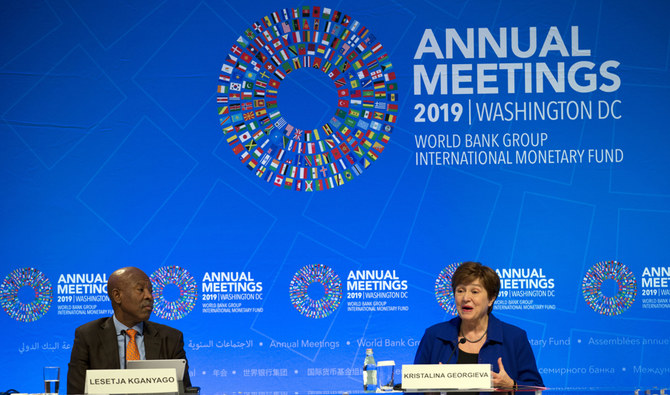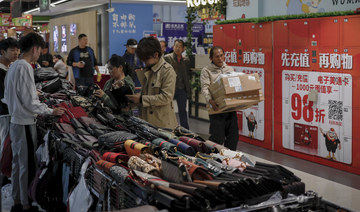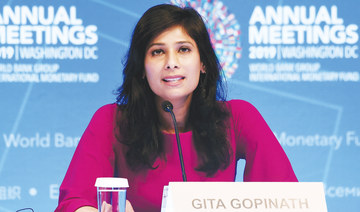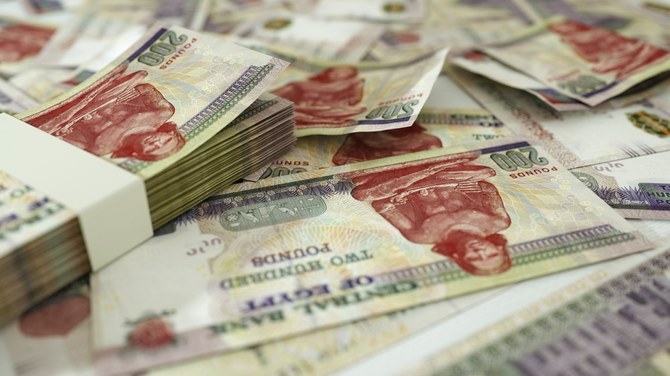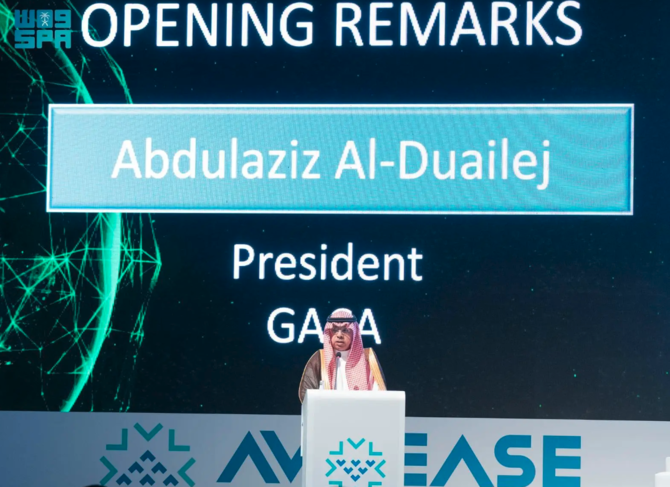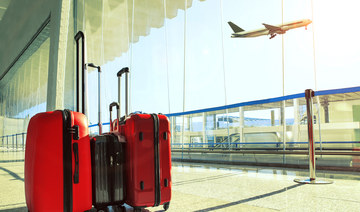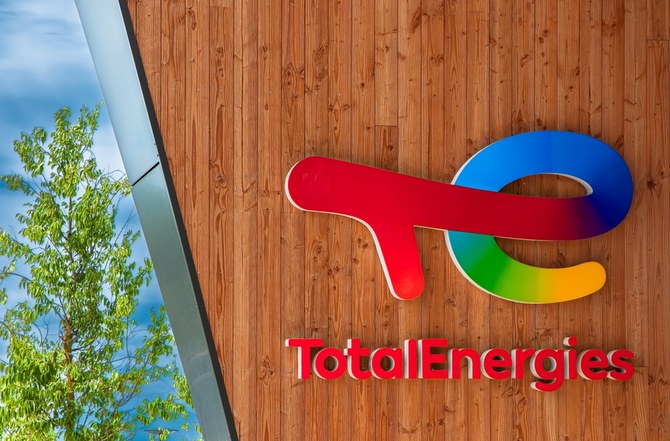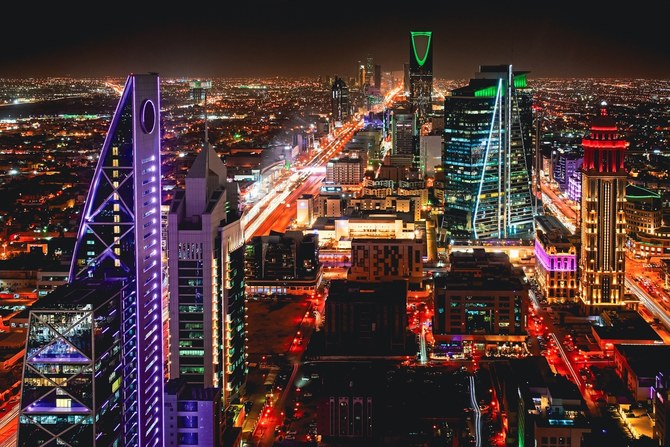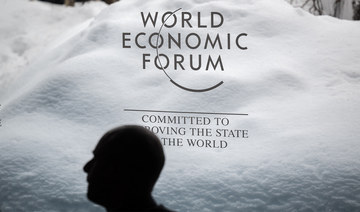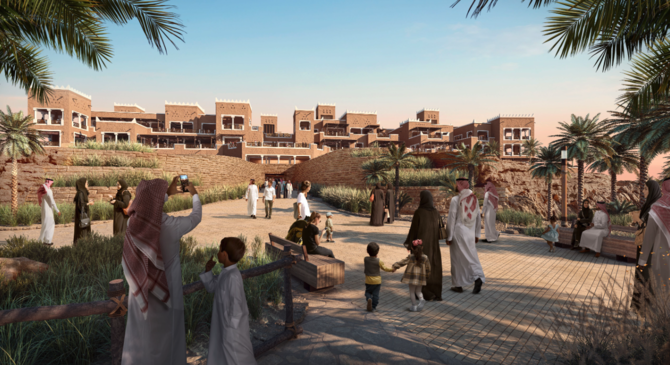WASHINGTON: The world’s most powerful policymakers are struggling to alleviate the pain of a slowing global economy with few levers left to pull and growing concern that one of them, negative interest rates, already is creating problems of its own.
In an ideal world, elected officials would pull more of the weight with fiscal programs and structural reforms that would improve growth and allow interest rates to rise.
But over three days of conversation here, the dilemma has become clear: Whether it is the US-China trade war, tightfisted spending in Germany, or the drawn-out Brexit, broader government policies are moving in the other direction — driving central bankers to mount further rescue efforts, and likely leading to even more negative yielding debt.
“We still have tools which could be used as necessary,” said Bank of Japan Governor Haruhiko Kuroda. “I don’t think the effect of monetary policy has declined significantly or materially.” Still, Kuroda said that a prolonged low interest rate situation could have “side effects on the financial system. You have to be careful.”
Negative interest rates are now a fact of life in Europe and Japan, and multiple other countries including the US are lowering their target policy rates.
“It is not really clear how we are going to get out of this,” Stanford University economics professor John Taylor said at a meeting of the Institute of International Finance.
He spoke at a central banking panel that showed just how much the landscape has shifted in the decade since the 2007 to 2009 financial crisis. Far from debate over whether unconventional policies are appropriate or not, the discussion is now about whether traditional central banking can even survive — or whether oddities like negative rates have become self-reinforcing, and whether central banks will need to begin overtly financing government programs to get the fiscal spending that may provide an exit from them.
“We have got to make it easier for politicians to run fiscal policy when monetary policy is essentially not operating well,” said former Federal Reserve vice chair Stanley Fischer, now a senior adviser with investment management firm BlackRock.
Conversation at the International Monetary Fund and World Bank meetings this week was dominated by two concerns — a global economic slowdown driven by “policy shocks” that might have been avoided, and the risks to pension funds, banks, and overall financial stability posed by the roughly $15 trillion, estimated by the IMF, in bonds that now pay a negative interest rate.
With easier monetary policy being used to dampen the impact of the trade war and other risks, some analysts worry about the moral hazard of central bankers underwriting the very policies they feel are slowing growth.
“There is a kind of benign view that central banks are just kind of doing their best to offset the damage done by one set of policymakers in one side of the government,” said Brian Coulton, chief economist at Fitch Ratings. “There is a real danger in misplaced faith in the capacity of central banks to fix all these growth challenges.”
Yet they may have no choice. IMF economists slashed their forecasts for global growth to the slowest pace since the 2008-2009 financial crisis, ahead of the conference, setting the tone for a somber mood.
In a communique issued on Saturday, the IMF’s steering committee said member countries should “employ all appropriate policy tools, individually and collectively, to mitigate risks.”
With interest rates close to or below zero, asset purchases are now the main policy tool for some central banks. The ECB, for example, has cut its key rate to a record low of minus 0.5 percent and launched an indefinite bond buying program that will likely keep it in the market for years to come.
“The risks surrounding the euro area growth outlook remain tilted to the downside,” outgoing ECB President Mario Draghi said at the IMF meeting on Friday. “The Governing Council continues to stand ready to adjust all of its instruments.”
Beyond the euro zone, the US and Japan, other nations are also easing rates. The Russian central bank, which has been cutting rates this year as economic growth slowed and inflation waned, will be ready to act “more decisively” when cutting interest rates, Governor Elvira Nabiullina said.
Ukraine central bank Deputy Governor Kateryna Rozhkova said the bank intends to cut the key policy rate gradually.
While lower rates support growth, the consequence of ultra-accomodative policy is that it can breed higher risk taking, as investors search for yield, said experts.
“We do worry about the side effect, which is that investors are reaching for yield,” said Tobias Adrian, financial counselor and director of the IMF’s monetary and capital markets department. “That is ultimately what is driving high yield bonds into negative territory in some parts of the world.”
Adrian pointed to leverage rising in the corporate sector and said the IMF saw stretched valuations in some equity markets, many corporate bond markets, and government bond markets around the world.
Negative interest rates may be hiding “deep underlying problems,” said Ásgeir Jónsson, governor of the Central Bank of Iceland. They’re a “sign of sickness for developed economies.”




